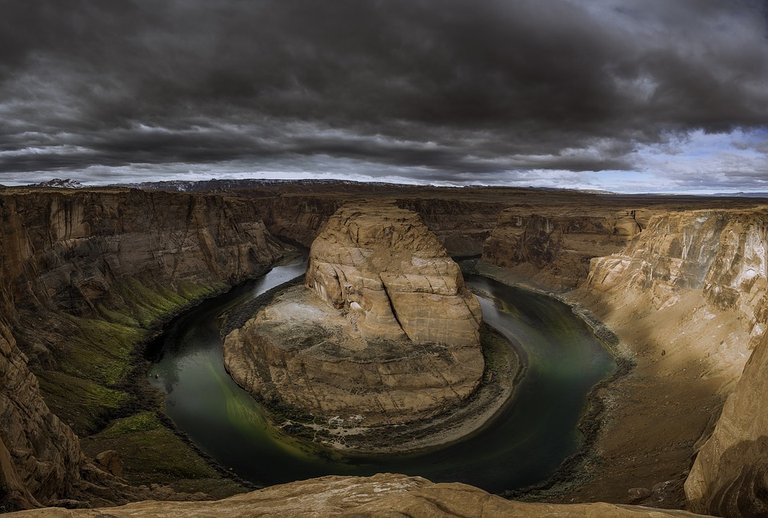
If we think about it, then we have a faulty concept of rock, because even a great stone can be destroyed through a process often called "weathering". But keep in mind that to destroy large stones takes a long time. in addition to rocks, weathering can also occur in soil and other earth layers.
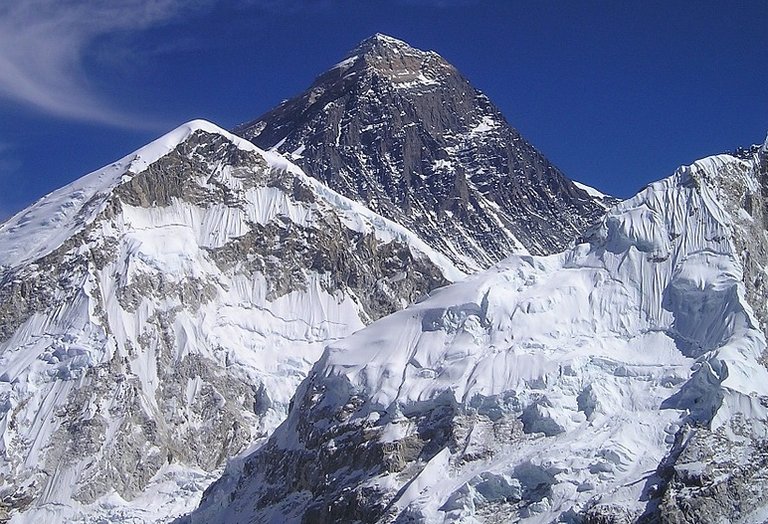
Weathering is the process of changing rocks into soil by either physical or mechanical processes (disintegration) or by chemical processes (decomposition). Decomposition process can lead to the occurrence of new minerals. (Sawkins et al., 1978: 346)
The process of weathering the rocks to the soil occurs physically and chemically. The physical process (disintegration) occurs due to wind-blown erosion, water erosion, and splits due to freezing and melting ice in rocks. The chemical weathering process occurs due to chemical reactions (Redana, 2010).
Weathering is one of the processes that accelerate denudation. Rocks, both igneous, sedimentary and metamorphic rocks exposed above the surface, in contact with the atmosphere, hydrosphere and biosphere will undergo a weathering process. Rocks will be physically and / or chemically altered. In nature, these two processes are difficult to distinguish, because they take place simultaneously. But theoretically these two processes are distinguished. This weathering process is one of the processes that change the surface of the earth at any time even though the change is not immediately apparent, as has been pointed out that the time factor is very influential in this process.
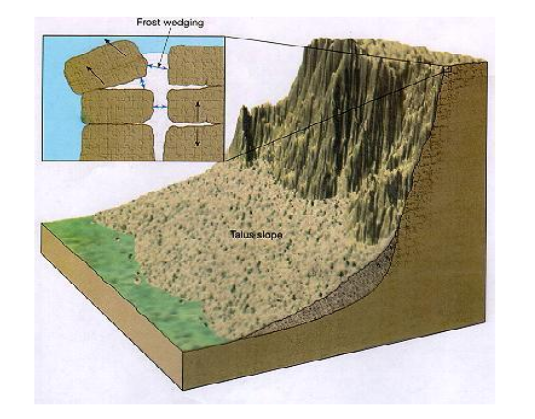
Physical Weathering
The process of Physical Weathering
Primary or rock minerals are split into fragments due to physical weathering. This encourages the creation of environmental conditions that greatly aid chemical weathering. There are several forms of physical weathering:
Abrasion : water carrying rock fragments has the effect of eroding the surface it passes. An example is scour by glacier, krikil, krakal, rock chunks that move along the flow of water.
Wetting and dryin : Water permeates into the rocks and reacts with the constituent constituents of rock.
Reezing and thawing : If water is impregnated in rocks / gaps in the rocks, repeated freezing and liquefaction will lead to development and shrinkage (if water freezes its volume increases by about 9%).
Heating and cooling : Rock consists of various mineral constituents of rock. When experiencing warming due to sunlight, each mineral will expand and contract in cooling at different speeds. Temperature fluctuations in time will cause stress (due to differences in heat conductivity between minerals) that will weaken the bonds along the grain or crystal and will eventually break the rock.
Release of pressure : This is the reduction of pressure on the rocks due to the transfer of materials in the superiors. Pressure release will lead to rocks splitting along weak areas called "joints".
Crystallization : In the arid environment the water evaporates on the surface of the rock and the crystals are formed from the dissolved minerals. Over time, these crystals will grow and their volume continues to increase so as to create sufficient pressure to break the rocks.
Organism activities : Organism activities help to disintegrate rocks
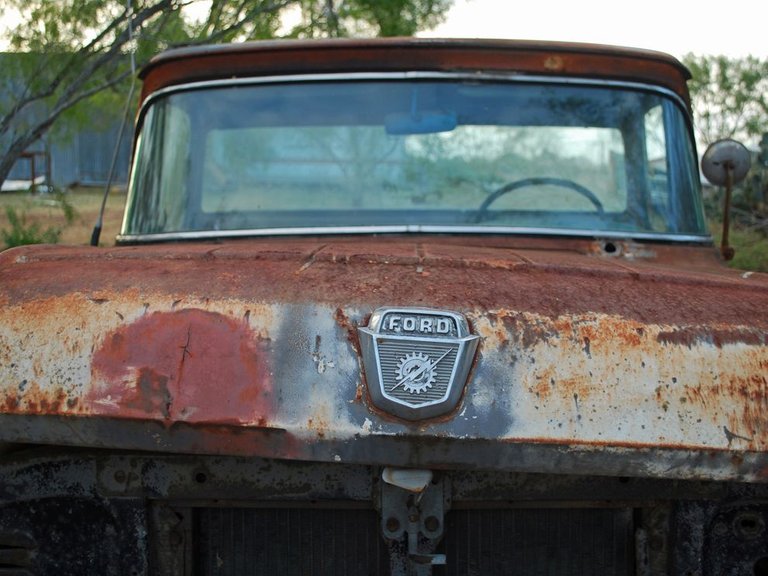
weathering chemicals
Chemical weathering process
- Hydration : Ions have a tendency to bind if H20 is available and dissociates. This process takes place in the arid region where there is salt. For example, chloride and sulfate decay due to hydration process. Generally, ions with the same charge but smaller radius have a larger H2O layer and therefore are not strongly absorbed. Small Li + ions tend to remain attached to the surface, while large Al3 + ions are strongly bonded and absorbed.

Hydrolysis : Water molecules on mineral surfaces dissociate into H + and OH- ions. H + ions infiltrate the crystal lattice, causing a charge imbalance, resulting in cations such as Ca2 +, Mg2 +, K +, and Na + diffused out.
Oxidation-reduction : Some primary minerals contain Fe2 + and Mn2 +. In the presence of oxidative environmental conditions Fe2 will oxidize to Fe3 + (settles as insoluble oxyhydroxide, usually one of ferrihydrite or mineral goethite) and Mn2 + to Mn3 + or Mn4 +, which causes positively charged and unstable minerals. This charge imbalance is neutralized by the loss of iron or oxidized manganese and / or some dissociated cations of minerals.
Complexation : Metals exempt from primary minerals such as Fe, Mn, and Al form complexes with organic components, such as the comic acid and the highly stable humic acid. One important thing in relation to chemical weathering is the loss of cations out of the system, thus causing an imbalance between cations and anions.
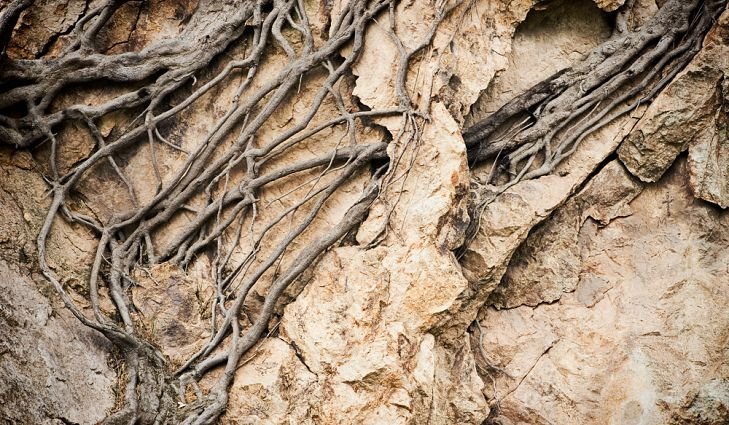
Weathering Biology
Breaking or decomposition of rocks due to animal or plant activities:
- Roots on cracks of rocks
The roots of plants sometimes loosens rock material. A plant growing in a crack can make the crack larger as the root spread out. This is known as root - pry. It is organic since this activity is caused by living things. - Termites, ants, insects breaking down organic matter + mixing with soil mineral.
- Decomposition of organic matter into organic + CO2
Conclusion
- The weathering of physics is the destruction of the rocks caused by the imprinting, the freezing of water, the sudden change of temperature or the great temperature difference between day and night.
- Chemical weathering is a weathering occurring as a result of chemical events. The chemical weathering results in ordinary jarst produce karren, ponor, underground rivers, lime columns, stalactite and stalagmite or limestone caves.
- Weathering Biological weathering occurs due to organic processes. The culprit is a living thing, can be by plants, animals, or humans, and the roots of the plant maupu fungi and moss can also destroy the rock.
Supporting literature / Reference
- Responsi, geology dasar, 2010, Departement pendidikan KM HMG “ARC-SINKLIN”
- Kusumadinata, K Ed.1979, Data Dasar Gunungapi Indonesia, Departemen Pertambangan Dan Energi, Direktorat Vulkanologi Bandung.
- Asikin, Sukendar. Basic of Geology. Departemen Geologi ITB
- Keller, Edward A.,1982, Enviromental Geology, Charles E Merril Publishing Company Columbus Ohio.
- Diktat Geologi Struktur. Laboratorium Geodinamik, Jurusan Geologi, FMIPA, UNPAD
- Tucker, Maurice. 1982. The Field Description of Sedimentary Rocks. Geological Society of London Handbook
All about my article part1, part2, part3, part4,part5, part6, part7, part8, part9, part10, part11, part12, part13.part14, part15.

by : @rabo
You received a 60.0% upvote since you are a member of geopolis and wrote in the category of "geology".
To read more about us and what we do, click here.
https://steemit.com/geopolis/@geopolis/geopolis-the-community-for-global-sciences-update-4
Peace, Abundance, and Liberty Network (PALnet) Discord Channel. It's a completely public and open space to all members of the Steemit community who voluntarily choose to be there.Congratulations! This post has been upvoted from the communal account, @minnowsupport, by rabo from the Minnow Support Project. It's a witness project run by aggroed, ausbitbank, teamsteem, theprophet0, someguy123, neoxian, followbtcnews, and netuoso. The goal is to help Steemit grow by supporting Minnows. Please find us at the
If you would like to delegate to the Minnow Support Project you can do so by clicking on the following links: 50SP, 100SP, 250SP, 500SP, 1000SP, 5000SP.
Be sure to leave at least 50SP undelegated on your account.
very good, you keep giving knowledge about geology.
Thank-you nyor feri 😂😂
Hahaha, Selaen thank you pu hana kata kata laen yang lebeh lagak 😆
Hahahhaha... Yang penteng bagah..